12.3 Managing Disk Space Usage in the Post Office
Many users are prone to save every message and attachment they ever receive. You can moderate this behavior by implementing disk space management:
-
Section 12.3.1, Understanding Disk Space Usage and Mailbox Size Limits
-
Section 12.3.2, Preparing to Implement Disk Space Management
-
Section 12.3.5, Restricting the Size of Messages That Users Can Send
-
Section 12.3.6, Preventing the Post Office from Running Out of Disk Space
-
Section 12.3.7, An Alternative to Disk Space Management in the Post Office
NOTE:The Linux/Mac client does not currently respect the mailbox size limits established in ConsoleOne.
12.3.1 Understanding Disk Space Usage and Mailbox Size Limits
The concept of mailbox size is different for client users than it is for you as an administrator. Users are most interested in the functional size of their mailboxes; that is, the number of items that they can store in their mailboxes. Administrators are usually more concerned about the physical disk space that mailboxes occupy.
Functional mailbox size is computed by adding the bytes occupied by individual messages. Users are notified when they exceed the functional mailbox size limit that you have set for them. Users can then identify items to delete or archive.
-
Windows client users can use to list items in the Trash folder, the Sent Items folder, the Mailbox folder, the Work in Progress folder, and any posted items. Item size is displayed in bytes and the list is sorted from largest to smallest, to easily identify candidates for deletion or archiving.
-
Linux/Mac client users can add a column to any folder Item List in order to identify large items.
-
WebAccess client users always have the column visible.
When client users have deleted or archived sufficient items, their functional mailbox size limit problem is resolved.
As an administrator, you want to set functional mailbox size limits that are reasonable for users and that make efficient use of the physical disk space that you have available. You are more concerned about physical disk space usage in the post office. Physical disk space usage is much more complex than counting the bytes occupied by individual messages.
The following factors influence physical disk space usage:
-
In a typical post office, 85% of disk space is occupied by attachments in the offiles directory structure. As mentioned above, attachments are compressed by 40% to allow more data to be stored in less space.
-
A large message sent to multiple users on the same post office is only stored on disk once, but counts against mailbox size for all recipients. If it is sent to multiple post offices, a copy is stored in each post office
-
A large distribution list can cause even a small message to take up substantial disk space. If all recipients are in the same post office, only one copy is stored, but if there are recipients in multiple post offices, a copy is stored in each post office
-
User databases (userxxx.db files) might contain large numbers of contacts and folders. Contacts and folders affect the size of the user databases, which have a maximum size of 2 GB, but do not count against the mailbox size for users.
-
Shared folders count only against the owner’s mailbox size, even though sharing with users in other post offices uses disk space in those post offices as well.
-
A messages is stored until the last recipient deletes and empties it. As a result, you might attempt to reduce post office disk space usage by reducing certain users’ mailboxes, but disk space usage does not change. This can occur because large messages eliminated from the reduced mailboxes still exist in other mailboxes.
Because of the complexity of these factors, you might consider a progressive strategy to determine the appropriate functional mailbox limits for your users.
For a new post office, you could check the physical disk space occupied by the post office before users start accumulating e-mail and initially set no functional mailbox limits. After a period of time (for example, a month), see how much the post office has grown. Run a report, as described in Section 30.1, Gathering Mailbox Statistics, to assess the rate of mailbox growth, then start setting functional mailbox limits based on user needs and available physical disk space. To set mailbox limits, skip to Section 12.3.3, Setting Mailbox Size Limits.
For an existing post office, where users have never had functional mailbox limits set in the past, continue with Preparing to Implement Disk Space Management.
12.3.2 Preparing to Implement Disk Space Management
If you are implementing disk space management in an existing GroupWise system, you must begin by setting the initial size information on all users’ mailboxes.
To establish current mailbox size:
-
In ConsoleOne, browse to and select a Post Office object.
-
Click > >
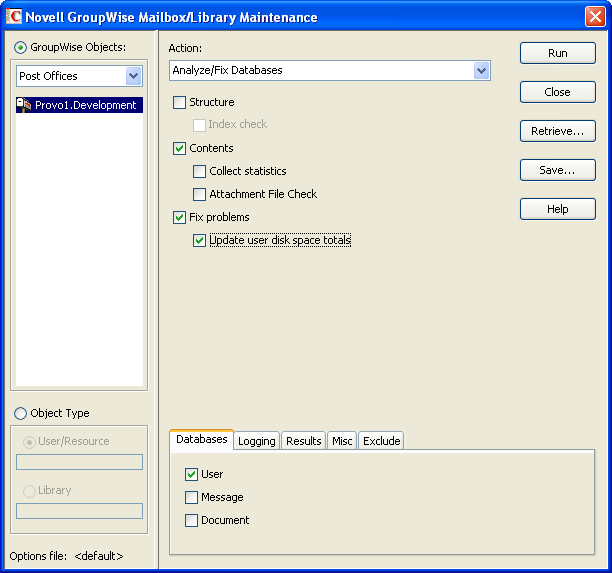
-
In the field, select .
-
In the field, select .
-
As options to the action, select , , and . Make sure all other options are deselected.
-
On the tab, select . Make sure all other types of databases are deselected.
-
Click , then click to acknowledge that the Mailbox/Library Maintenance task has been sent to the POA.
After the POA has performed the task, current mailbox size information becomes available on each user’s mailbox. The information is updated regularly as the user receives and deletes messages.
-
To generate a report of current mailbox information, follow the instructions in Section 30.1, Gathering Mailbox Statistics.
-
Repeat Step 1 through Step 8 for each post office where you want to implement disk space management.
-
Continue with Section 12.3.3, Setting Mailbox Size Limits.
12.3.3 Setting Mailbox Size Limits
After initial size information is recorded on each user’s mailbox, you can establish a limit on the amount of disk space each user’s mailbox is allowed to occupy. You can set a single limit for an entire domain. You can set different limits for each post office. You can even set individual user limits if necessary.
If you are implementing disk space management in an existing GroupWise system where users are accustomed to unlimited disk space, you should warn them about the coming change. After you establish the mailbox size limits as described in this section, users whose mailboxes exceed the established limit cannot send messages until the size of their mailboxes is reduced. Users might want to manually delete and archive items in advance in order to avoid this interruption in their use of GroupWise.
To establish mailbox size limits:
-
In ConsoleOne, browse to and select a Domain, Post Office, or User object.
-
Click > > .
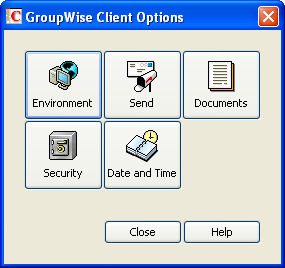
-
Click > .
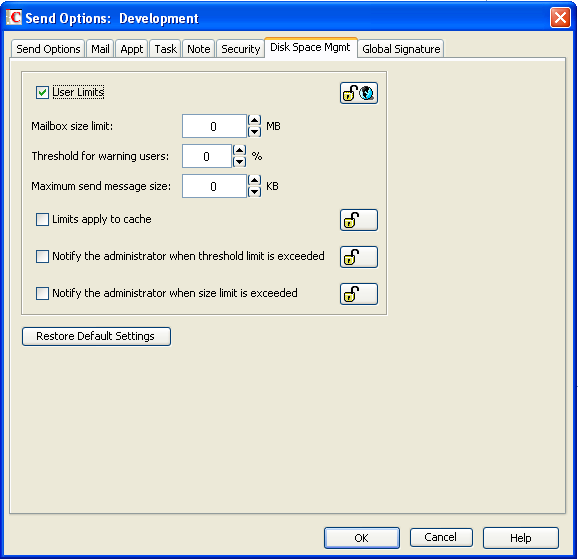
-
Select .
-
Specify the maximum number of megabytes allowed for each user’s mailbox.
Unless disk space is extremely limited, 200 MB is a comfortable mailbox size to enforce for typical users. However, users who regularly receive large attachments would need a substantially higher limit. The maximum size limit that you can set for mailboxes is 4 TB.
-
Specify as a percentage the point where you want to warn users that their mailboxes are getting full.
After a user receives a warning message, he or she can continue to send messages until the size limit is reached. After the size limit is reached, users must reduce the size of their mailboxes in order to send additional messages.
-
Optionally, specify in kilobytes the largest message that users can send.
By restricting message size, you can influence how fast users’ mailboxes fill up. However, if users have valid reasons for sending messages that exceed this limit, the limit can become a hindrance to users getting their work done.
-
Click > to save the disk space management settings.
-
If you are adding disk space management to an existing GroupWise system where users’ mailboxes are already over the desired size limit, continue with Section 12.3.4, Enforcing Mailbox Size Limits.
or
If you are implementing disk space management in a new system where users have not yet begun to use their mailboxes, see
Using Mailbox Storage Size Information
inMaintaining GroupWise
in the GroupWise 8 Windows Client User Guide to see how setting a mailbox size limit affects users’ activities in the GroupWise client.
12.3.4 Enforcing Mailbox Size Limits
If existing GroupWise users are having difficulty fitting their mailboxes into the established mailbox size limits, you can assist them by reducing the size of their mailboxes for them.
When users archive and empty messages in their mailboxes, the messages are marked for removal from the database (“expired”), but the disk space that the expired messages occupied in the databases is retained and used again for new messages. As a result, archiving and deleting messages does not affect the overall size of the databases.
The Expire/Reduce Messages option of Mailbox/Library Maintenance enables you to expire additional messages and reduce the size of the databases by reclaiming the free space in the databases that is created when messages are expired. You should inform users before you run this process so they have a chance to archive or delete messages. Unread messages are not expired.
-
In ConsoleOne, select a Post Office object.
-
Click > > .
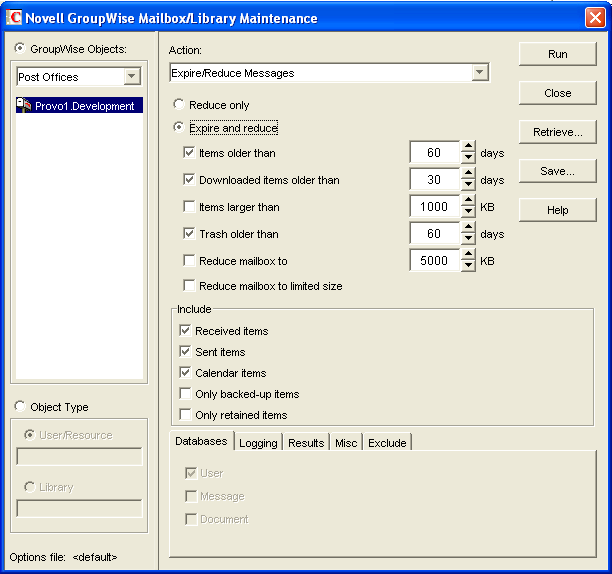
-
In the field, select .
-
Set the and options as desired, making sure that is selected.
-
Click , then click to acknowledge that the Mailbox/Library Maintenance task has been sent to the POA.
After the POA has performed the task, users mailboxes fit within the mailbox size limit you have established.
-
Repeat Step 1 through Step 5 for each post office where you want to reduce user mailboxes to the established mailbox size limit.
See Using Mailbox Storage Size Information
in Maintaining GroupWise
in the GroupWise 8 Windows Client User Guide to see how setting a mailbox size limit affects user activities in the GroupWise client.
12.3.5 Restricting the Size of Messages That Users Can Send
By restricting message size, you can influence how fast user mailboxes fill up. However, if users have valid reasons for sending messages that exceed this limit, the limit can become a hindrance to users getting their work done.
For HTML-formatted messages, the MIME portion of the message counts in the message size. MIME files can be large. If a user cannot send an HTML-formatted message, he or she could use plain text instead, in order to decrease the size of the message so that it falls within the message size restriction.
There are four levels at which you can restrict message size:
Within the Post Office
You can use Client Options to restrict the size of messages that users can send within their local post office.
-
In ConsoleOne, browse to and select a Domain, Post Office, or User object.
-
Click > > .

-
Click > .

-
Select .
-
Specify in kilobytes the largest message that users can send.
-
Click , then click to save the maximum message size setting.
Between Post Offices
You can configure the POA to restrict the size of messages that it allows to pass outside the local post office. See Section 36.2.7, Restricting Message Size between Post Offices for setup instructions.
Between Domains
You can configure the MTA to restrict the size of messages that it allows to pass outside the local domain. See Section 41.2.1, Restricting Message Size between Domains for setup instructions.
Between Your GroupWise System and the Internet
You can configure the Internet Agent to restrict the size of messages that it allows to pass to and from your GroupWise system by setting the size limits in a customized class of service. See Section 47.1, Controlling User Access to the Internet for setup instructions.
12.3.6 Preventing the Post Office from Running Out of Disk Space
In spite of the best disk space management plans, it is still possible that some unforeseen situation could result in a post office running out of disk space. To prevent this occurrence, you can configure the POA to stop processing messages, so that disk space usage in the post office cannot increase until the disk space problem is resolved.
-
In ConsoleOne, double-click a Post Office object, right-click its POA object, then click .
-
Click > , then adjust the settings in the and fields as described in Section 36.4.2, Scheduling Disk Space Management.
-
Click > .
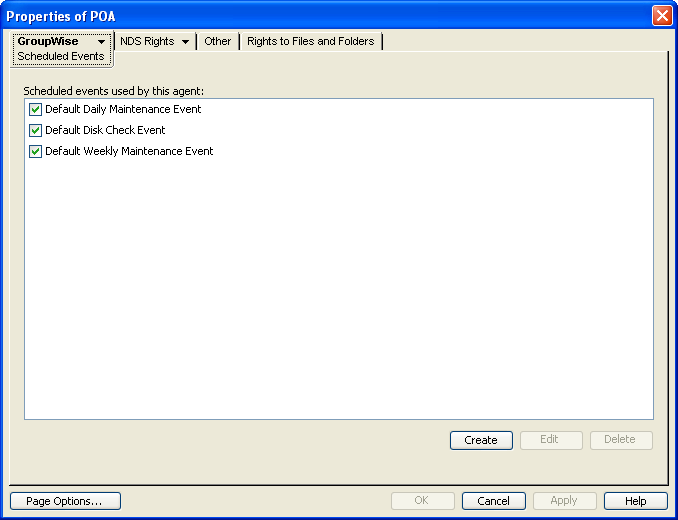
The Default Disk Space Management Actions trigger a Reduce on user and message databases at 2048 KB (2 GB) and stop mail processing at 200 MB. You can edit the Default Disk Space Management Actions so that all post offices are affected, or you can create a new set of Disk Space Management actions to assign to specific post offices.
-
Click to create a new scheduled event to handle an unacceptably low disk space condition.
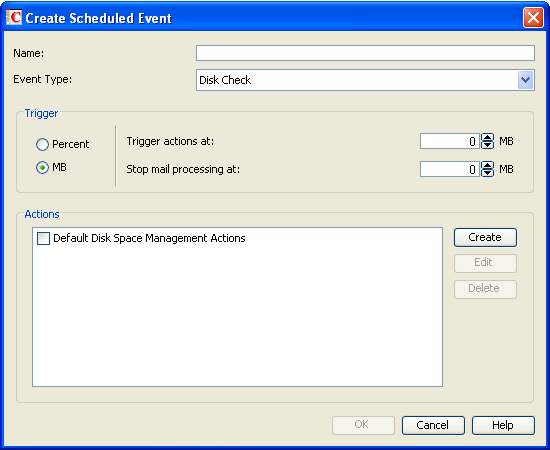
-
Type a unique name for the new scheduled event, then select as the event type.
-
In the field, specify the amount of free post office disk space at which to take preventive measures.
-
Click to define your own disk check actions, then give the new action a unique name.
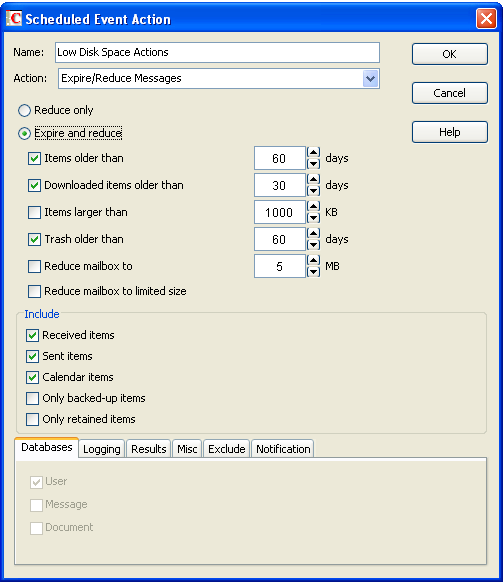
-
Configure the actions for the POA to take in order to relieve the low disk space condition.
Use the or tab if you want to receive notification about the POA’s response to the low disk space condition.
-
Click to return to the dialog box.
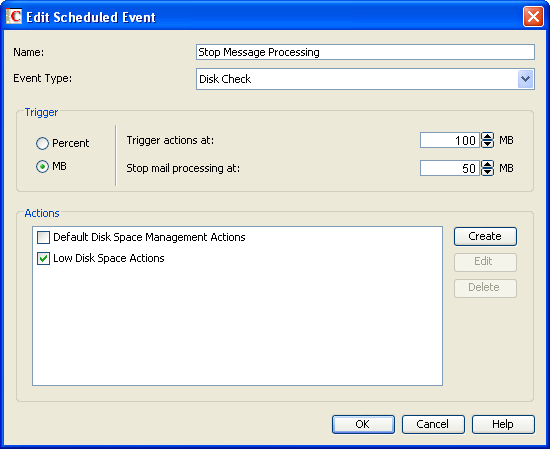
-
In the field, specify the amount of free post office disk space at which you want the POA to stop processing messages.
-
Click to create the new disk space management event and return to the page.
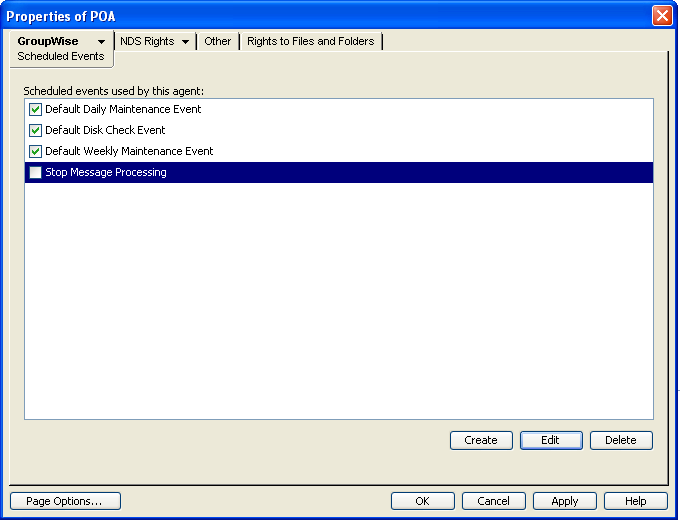
-
Select the new disk space management event.
-
Click to close the Scheduled Events page.
ConsoleOne then notifies the POA to restart so the new disk space management event can be put into effect.
For additional instructions, see Section 36.4.2, Scheduling Disk Space Management.
12.3.7 An Alternative to Disk Space Management in the Post Office
If you want to place more responsibility for disk space management onto GroupWise client users, you can require that they run the client in Caching mode, where all messages can be stored on user workstations, or other personal locations, rather than in the post office. For an overview of Caching mode, see:
IMPORTANT:Do not force Caching mode for a post office that supports Outlook clients along with GroupWise clients.
12.3.8 Forcing Caching Mode
You can force Caching mode for an entire domain. You can force Caching mode for specific post offices. You can even force Caching mode for an individual user if necessary.
When you initially force caching mode, users’ Caching mailboxes are identical with their Online mailboxes. However, as you employ disk space management processes in the post office and reduce the size of users’ Online mailboxes, more and more of the users’ mailbox items exist only in their Caching mailboxes. Make sure that users understand their responsibilities to back up their Caching mailboxes, as described in:
To force Caching mode:
-
In ConsoleOne, browse to and select a Domain, Post Office, or User object.
-
Click > > .

-
Click > .

-
In the box, select .
-
Click , then click to save the Caching mode setting.
If you are helping existing users, who might have sizeable mailboxes, to start using Caching mode exclusively, you can configure the POA to respond efficiently when multiple users need to download their entire mailboxes for the first time. See Section 36.2.6, Supporting Forced Mailbox Caching for setup instructions.